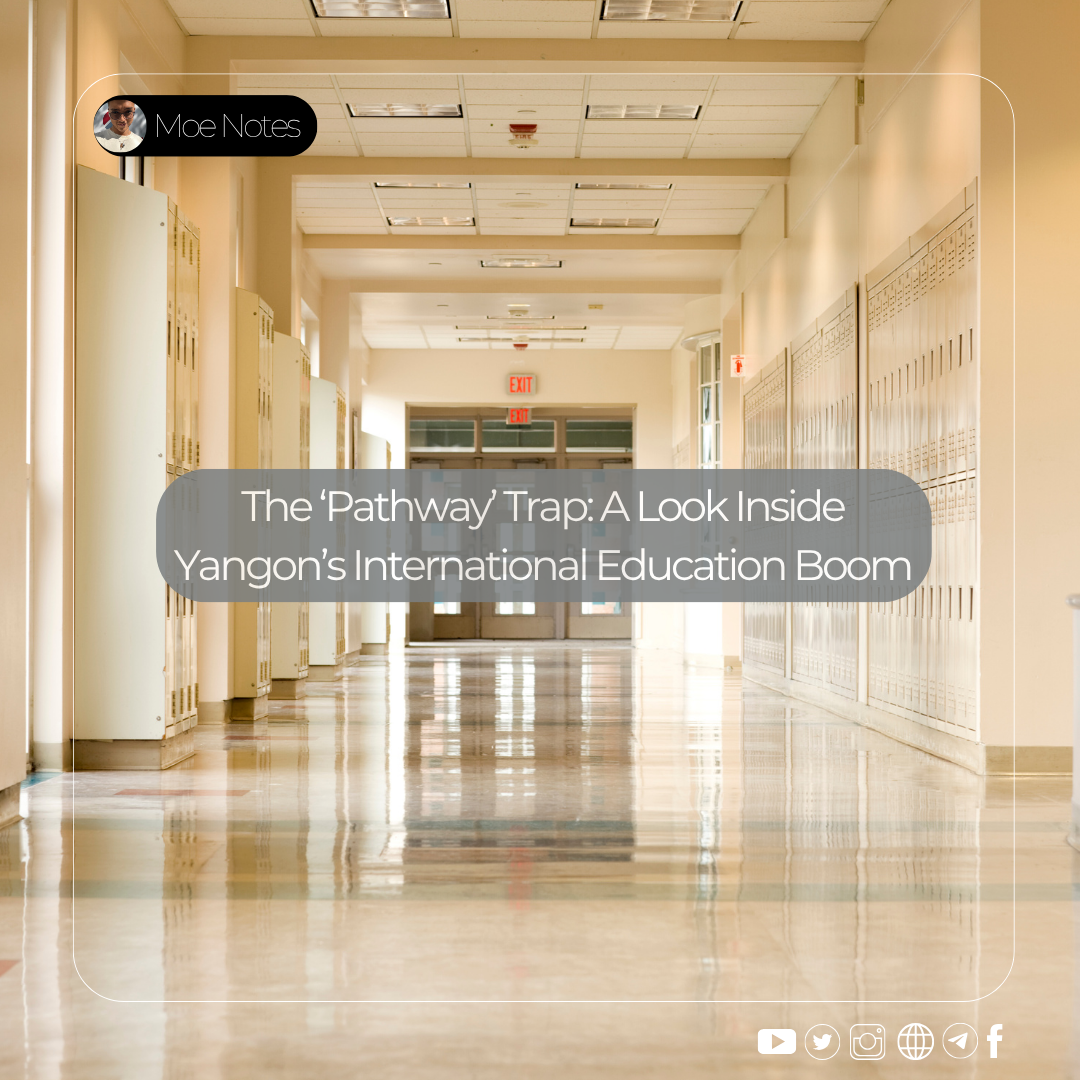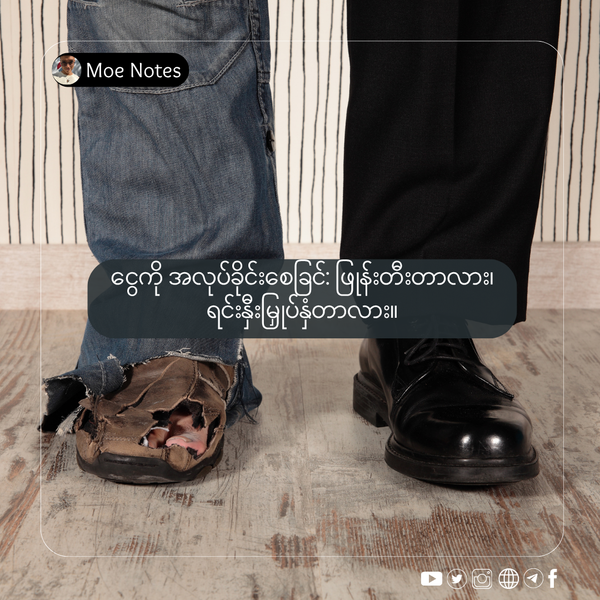The ‘Pathway’ Trap: A Look Inside Yangon’s International Education Boom

"A school is a place that teaches you how to face the real world. It's not just an arena for competing with books and pencils."
(Read Time: 30 Minutes)
Introduction: The Dream for Sale
In a country facing immense political and economic turmoil, the dream of an international education has become more than just an aspiration; for many young people in Myanmar, it is the only viable escape route. This desperation has created a booming, unregulated market for private “international” schools in cities like Yangon, all promising a fast track to a university abroad.
They sell a beautiful dream: a globally recognised diploma, earned in a fraction of the time, for a fraction of the cost. But what are they actually selling? As someone who has been through this system, I feel a responsibility to pull back the curtain and reveal the truth behind the “pathway” trap. This is a case study of a system built on high demand and low investment, and the consequences it has for the students who are its primary customers.
Part 1: The Foundation - A System Built on Rote Learning
To understand why these “pathway” schools are so appealing, you must first understand the system that students are trying to escape. The traditional Burmese education system is built on one primary principle: rote memorisation.
From a young age, we are taught that “learning” means memorising the textbook, and “success” means reproducing that information perfectly in an exam. The student with the highest score is the “best” student. There is no room for critical thinking, collaboration, or creative problem-solving. It is a system that measures a fish by its ability to climb a tree.
This creates students who are excellent at passing exams but are often unprepared for the intellectual demands of a Western university, where they are expected to question, analyse, and create, not just remember.
Part 2: The Anatomy of a “Pathway” School
It is into this environment that the “international pathway” schools have emerged. They offer a simple, seductive promise: “We can get you the international qualification you need to study abroad, and we can do it in one year.”
The Business Model: Maximum Profit, Minimum Investment
Their core business model is brutally efficient. In a country where parents are desperate and regulatory oversight is weak, the goal is often to maximise profit by minimising investment. Who is supposed to be regulating these schools? The Ministry of Education? Where is the quality control? It’s nonexistent. What can you expect from an organisation that has initiated a military-slave education system under the State Administration Council?
- Facilities: Why invest in a proper campus with a library, a sports field, or student common areas when you can cram students into a converted office building?
- Schedule: Why create a balanced schedule that considers a student’s ability to learn and their mental health when you can teach from 9 AM to 5 PM, back-to-back, to maximise teacher and classroom usage?
- The Target Audience: The primary customers are not the students; they are the parents. As long as the parents see that their child is getting good grades and will receive a diploma, they are satisfied. The actual quality of the education is rarely questioned.
The Teachers: The Underqualified Multitaskers
To cut costs, many of these schools hire teachers who are not qualified to teach an international curriculum. It is common to find a single teacher responsible for multiple, unrelated subjects. The same person might teach Mathematics, Chemistry, Physics, and Biology.
This is not the teacher’s fault. Many are dedicated educators from the Burmese system doing their best. But a teacher who is an expert in the Burmese matriculation curriculum cannot, overnight, become an expert in teaching an A-Level or OSSD curriculum. The teaching methodologies, the core concepts, and the assessment criteria are completely different.
The Curriculum: A Three-Year Marathon Crammed into a Sprint
This is perhaps the biggest deception. These schools often take a curriculum that is designed to be taught over two or three years (like IGCSE or A-Levels) and cram it into a single academic year.
The result is inevitable. There is no time for deep understanding. The only way to get through the material is to revert to the only method the students and teachers know: rote memorisation. The teaching style regresses to the old Burmese system, but with an international textbook. My favourite analogy for this is: in class, they teach you that "1 + 2 = 3,” but in the exam, they ask you, “How do you cook rice?” The questions aren’t just harder; they are completely unrelated to the way you were taught to think.
Part 3: The Consequences - A Student’s Journey
Let’s imagine a student, “Maung Maung.” His family has invested their life savings into one of these pathway schools. He works hard, memorises everything, gets good grades, and receives his international diploma. He has “succeeded.”
Then, he arrives at a UK university, and his world falls apart.
- The Classroom Shock: He enters a tutorial where the professor doesn’t lecture, but asks, “What do you think?” He is terrified to speak because in his old system, questioning the teacher was a sign of disrespect.
- The Collaboration Problem: In group projects, he doesn’t know how to share ideas or accept criticism. He sees his classmates as competitors, not collaborators.
- The Critical Thinking Gap: When faced with an essay that requires him to analyse and form his argument, he is lost. He only knows how to repeat information, not how to create it.
This is the real price of the “pathway” trap. Students arrive in the UK with a certificate that says they are ready, but with an educational foundation that leaves them completely unprepared for the reality of Western academia.
Part 4: The Hard Questions You Must Ask
Should we just accept this situation as “normal”? Is the risk you’re taking truly worth the reward? Before choosing a school, every student and every parent should ask these difficult questions.
- Teacher Qualifications: “What degrees do your teachers hold? How much experience do they have teaching this specific international curriculum?”
- Curriculum Details: “Can I see a detailed curriculum for the entire academic year in advance?”
- Success Rates: “What percentage of your graduates get into their first-choice university and Major?”
- Access to Current Students: “Can I speak with current students or recent graduates without a staff member present?”
- Accreditation: “Can you show me the official accreditation for your partner school from the relevant country’s Ministry of Education?”
You should be wary of any school that cannot or will not answer these questions clearly. It is also important to note that current parents and students at these schools may be reluctant to speak negatively about their own choice, either out of pride or a desire to protect their investment. Trust your gut.
The Silencing of Criticism
In our country, when an organisation receives criticism, the common response is not to self-reflect and improve, but to try and silence the critic. They delete negative reviews, they intimidate students, and they make them afraid to speak out.
In a country without freedom of speech, where the law is not on the side of the people, your voice is your only weapon. It is far better to ask these hard questions before you enrol than to live with regret after.
Part 5: The Real Education - A New Framework for Learning
The problem is not the student. The problem is the system. To truly prepare for an international education, we need to move beyond just passing exams and embrace a new way of learning. I call it the "“ Es”:
- Engage: The first contact with a new topic.
- Explore: The process of understanding how things work.
- Explain: The ability to articulate what you’ve learned.
- Elaborate: The ability to critique, differentiate, and apply knowledge to new situations.
- Evaluate: The final stage, where understanding and application merge. This is where true mastery happens.
This framework is not about memorising facts for an exam. It’s about building a deep and lasting understanding that can be applied to any problem in any field.
Conclusion: A Warning for Parents and a Call for Change
To the parents and students considering these pathway schools, I urge you to look beyond the promises of a quick and easy path. The fastest route is often the most flawed. Your child’s education is the most important investment you will ever make.
Ask the hard questions. Demand quality. Choose a place that will teach them how to think, not just what to memorise.
The existence of these schools is a symptom of a larger problem—a broken education system and a country in crisis. But that does not mean we have to accept this as our reality. By demanding better for ourselves and our children, we can begin to build a new foundation, one based on genuine learning, critical thinking, and the skills needed to thrive not just in the UK but in the world.



